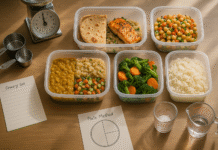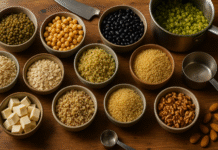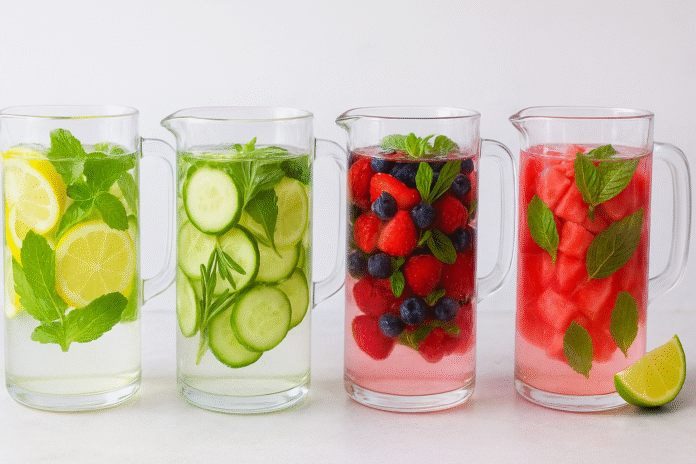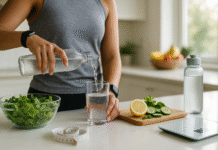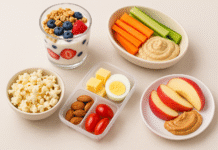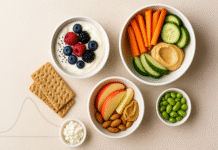For optimum health, you need to drink enough water. It influences your digestion, temperature control, cognitive function, and more. Plain water is still the best, but infused water—water steeped with fruits, vegetables, herbs, or botanicals—is a tasty and attractive alternative that makes people want to drink more water every day. This article gives you the seven finest infused water recipes for staying hydrated, using both science and cooking flair.
Why should you drink water with flavor?
- Better taste without adding more sugar
When you drink infused water, you get the natural sweetness and scent of fruit without the calories or synthetic sweeteners that are in a lot of store-bought drinks. - Getting more water
People who don’t like plain water frequently drink more when they can taste it. This reduces headaches, weariness, and other symptoms that occurs when you’re dehydrated. - Increase in micronutrients
Infusing fresh fruits and vegetables causes them to lose certain vitamins, minerals, and antioxidants. This provides you a slight health boost over regular water. - Encourages Drinking with Awareness
Making and drinking infused water is a way to be attentive and convert a simple job into a self-care ritual.
How to Pick
We choose each of the following recipes based on how well they work and how much fun they are to produce.
- Hydration Efficiency: Flavors that make you want to drink all day.
- Nutrient synergy: Two or more vitamins, antioxidants, or electrolytes work better together than alone.
- Availability by Season: Ingredients that are simple to find all year or when they are most in demand.
- Ease of preparation: No special tools required and easy to customize.
Ingredients for Recipe 1: Citrus and Mint Cooler
- 1 medium lemon, sliced into thin pieces
- 1 medium lime, sliced into thin pieces
- 1 orange, peeled and cut into pieces
- 8 to 10 fresh mint leaves that have been finely crushed
- 2 liters (8 cups) of filtered water
- Ice cubes that you can add
Getting Set
- Be sure to wash all the mint and citrus well.
- Slice the lemon and lime into rounds that are 1/4 inch thick. Cut the orange into pieces.
- Gently clap mint leaves between your palms to extract the oils out of them.
- Put a lot of fruit and mint in a pitcher and fill it with water.
- Let the flavors blend by putting it in the fridge for at least two hours (up to overnight).
- Put more mint sprigs over top and serve over ice.
Pros:
- Citrus fruits are a wonderful source of vitamin C, which supports the immune system and creates collagen.
- The menthol in mint makes it feel cool, which makes the drink taste great on hot days.
Modifications
- Using grapefruit instead of orange will make it taste more bitter and add more antioxidants.
- Add a spoonful of honey or agave if you want it to be sweeter.
Recipe 2: Cucumber, Rosemary, and Lemon
What you need
- Cut a huge cucumber in half and then thinly slice it.
- One lemon, sliced into thin pieces
- Two tiny pieces of fresh rosemary
- Two liters (eight cups) of cold water
- Ice is optional
Getting ready
- Clean the rosemary, lemon, and cucumber.
- Slice the lemon and cucumber into thin rounds.
- Put the contents in a pitcher and gently crush the rosemary sprigs.
- Add water and mix it in slowly. Put it in the fridge for two to four hours.
Pros:
- Cucumbers are 95% water and provide potassium, which helps keep fluids in balance.
- Rosmarinic acid is one of the compounds in rosemary that fights inflammation.
Advice
- Use English cucumbers without seeds for a smoother texture.
- To make the taste stronger, lightly crush rosemary in the bottom of each glass before pouring.
Recipe 3: Berry and Basil Bliss
Ingredients
- Cut up and hull ½ cup of strawberries.
- 1/2 cup of blueberries
- 8 to 10 fresh basil leaves
- 2 liters (8 cups) of water
- Crushed ice (optional)
Getting Ready
- Wash the berries and basil.
- Put basil, strawberries, and blueberries in a pitcher.
- Put the ingredients in the fridge for four hours or overnight after pouring water over them.
Pros:
- Anthocyanins in berries are excellent for your heart and lessen oxidative stress.
- Basil tastes sweet and peppery and has antibacterial effects.
Switch
- Switch out blackberries or raspberries based on what is in season.
Recipe 4: Watermelon and Mint Refresher
What You Need
- 2 cups of watermelon cut into cubes
- 8 to 10 leaves of mint
- 2 liters (8 cups) of water
- Optional lime wedges to serve with
Getting Ready
- Cut the watermelon without seeds into cubes and save a couple for decoration.
- Lightly muddle the watermelon and mint at the bottom of a pitcher.
- Add water, mix, and let it cool for two hours.
Things that are good
- Lycopene is found in a lot of watermelon, and it helps keep cells from becoming hurt.
- Watermelon’s natural electrolytes, potassium and magnesium, help you recover after working out.
Recipe 5: Ginger, Lemon, and Turmeric Zing
Ingredients
- Cut a piece of fresh ginger that is 1 inch thick into thin slices.
- Cut up one lemon
- 1 inch of fresh turmeric, sliced into slices, or 1/2 teaspoon of ground turmeric
- A little black pepper (helps turmeric get into the body)
- Two liters (eight cups) of water
Getting Set
- Peel and cut ginger and turmeric into small pieces.
- Put ginger, lemon, turmeric, and pepper in a pitcher and add water.
- Refrigerate for 4 to 6 hours, then filter before serving.
Pros:
- Curcumin, which is present in turmeric, is a powerful anti-inflammatory and antioxidant.
- Ginger can assist with upset stomachs and nausea.
Recipe 6: Pineapple, Mint, and Lime Tropic
Things You Need
- 1 cup of fresh pineapple chunks
- The juice and zest of one lime
- 8 to 10 mint leaves
- Water: 8 cups (2 liters)
Getting Ready
- Slice the pineapple into small pieces that are easy to eat.
- Fill a pitcher with water and add pineapple, lime zest or juice, and mint.
- Let it cool for at least three hours. You can strain it if you like.
Pros:
- Bromelain in pineapple helps break down proteins and decreases swelling.
- Lime has vitamin C, which helps your body take in iron from other meals.
Recipe 7: Apples, Cinnamon, and Cloves Comfort
Things that go inside it
- One apple, sliced thinly (any sort)
- Two cinnamon sticks
- 4 entire cloves
- Two liters (eight cups) of water
Getting ready
- Core the apple and cut it into pieces.
- Add water to a pitcher with apples, cinnamon, and cloves.
- Let it sit overnight to have a taste that reminds you of fall.
Things that are good
- Cinnamon can help keep blood sugar levels stable and fight germs.
- Polyphenols in apples are excellent for your intestines.
Best Ways to Infuse and Serve
- Wash all produce: To get rid of pesticides, waxes, and pathogens, you should wash all of your fruits and veggies.
- Storage: Keep infused water in the fridge and drink it within 24 to 48 hours to stop bacteria from forming.
- Choose a pitcher: Use pitchers or glass that don’t have BPA in them. Avoid metals that can modify the taste.
- Change the strength: Let it steep for 1 to 2 hours if you want a milder flavor, or up to 12 hours (overnight) if you want a stronger flavor.
- Reusable Produce: After the first infusion, fruits and herbs can be used to prepare a second, less strong batch.
Frequently Asked Questions
- Is infused water as good for you as regular water?
Yes. Infused water is still mostly water, thus it hydrates the body the same way regular water does. People might even eat more because of the extra flavors. - Is it permissible to utilize fruit that has been frozen instead of fresh?
Yes, of course. Frozen fruit cools the water straight away and also makes it taste better. Just keep in mind that it can make the drink weaker when it thaws. - How long can I store water that has been flavored?
Within 24 hours is when the highest quality is. After 48 hours, microbial growth and oxidation can make food less safe and appetizing. - Is it okay to use the same ingredients for a second infusion?
Yes, however the flavor will be less strong. Rosemary and mint are two herbs that are easier to work with. Most of the time, fruits lose most of their flavor after the initial infusion. - Is there anything that makes you feel unsafe?
Check to see that all the food is clean and in the fridge. Don’t let infused water sit at room temperature for too long. - What kind of infused water is best to drink after working out?
Watermelon and mint (Recipe 4) and cucumber, lemon, and rosemary (Recipe 2) are two meals that are fantastic since they have magnesium and potassium in them. - Is it okay to add vitamins or electrolytes?
Yes. You can safely add a little sea salt, coconut water, or a powdered electrolyte combination to your drink to help you rehydrate faster.
To sum up
Adding flavor to water is an easy yet effective approach to improve your hydration habit. Adding fresh fruits, herbs, and spices to water can make it taste better and give you more nutrients. This will also make you want to drink it more. These 7 finest infused water recipes can please a lot of different people and meet their nutritional needs. You can choose between the refreshing smell of apple, cinnamon, and clove or the zesty burst of citrus and mint. Infusion is a great way to get your body to keep hydrated, which will provide you long-lasting energy, bright skin, and good health.
References
- Healthline. “9 Refreshing Infused Water Recipes.” Healthline. https://www.healthline.com/nutrition/infused-water-benefits
- UCSF Health. “Water: The Key to Optimal Health.” https://www.ucsfhealth.org/education/water-the-key-to-optimal-health
- Mayo Clinic. “Water: How much should you drink every day?” https://www.mayoclinic.org/healthy-lifestyle/nutrition-and-healthy-eating/expert-answers/water/faq-20058506
- Harvard T.H. Chan School of Public Health. “The Nutrition Source: Water.” https://www.hsph.harvard.edu/nutritionsource/water/
- Gupta, S. et al. “Antioxidant and anti-inflammatory properties of rosemary.” Food Chemistry. https://www.sciencedirect.com/science/article/pii/S0308814608002982
- Jarrell, J. “Anthocyanins in berries and their health effects.” Journal of Agricultural and Food Chemistry. https://www.ncbi.nlm.nih.gov/pmc/articles/PMC2850940/
- Dr. Linda Huang. “Hydration and electrolytes.” Journal of Sports Science & Medicine. https://www.ncbi.nlm.nih.gov/pmc/articles/PMC4772032/
- McCarty, M. “Turmeric/curcumin and health.” Alternative Medicine Review. https://pubmed.ncbi.nlm.nih.gov/17569207/
- Lete, I., Allué, J. “The effectiveness of ginger in the prevention of nausea and vomiting during pregnancy and chemotherapy.” Critical Reviews in Food Science and Nutrition. https://www.ncbi.nlm.nih.gov/pmc/articles/PMC6341159/
- Maurer, H.R. “Bromelain: Biochemistry, pharmacology and medical use.” Cellular and Molecular Life Sciences. https://pubmed.ncbi.nlm.nih.gov/12873751/
- Kasture, S., Khanna, S. “Role of apple polyphenols in health.” Journal of Nutritional Biochemistry. https://academic.oup.com/jn/article/136/6/1781/4664033





